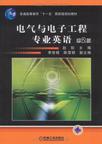电气与电子工程专业英语
出版时间:2009-9 出版社:机械工业出版社 作者:赵阳 页数:259
前言
本书是编者在2005年出版的《电气与电子工程专业英语》的基础上,根据多年的国外大学教学经验,参考国内外最新出版的教材、专著及科技资料,新增了第5章电力系统、第9章电力电子技术及第12章计算机技术,删除了第1版中第5、11、14章及第15章内容,并修改、调整了其他章节的相应部分内容,修订而成的。 本书为普通高等教育“十一五”国家级规划教材。全书共14章,分为电气电子工程基础篇、电气工程篇、电子工程篇和信息与计算机工程篇4部分。 本书从实际教学的需要出发,结合了电类专业的特点,专业词汇覆盖面广,内容由浅入深,力求语言流畅、图文并茂、原汁原味,具有较强可选性。本书具有如下特点。 1.选材广泛。涵盖了电类专业的专业基础及专业课程,包括了“信息与计算机”等时代性强的内容。 2.层次多样。每部分都安排了简单的和有一定难度的章节,读者可根据自己的实际情况进行选用。 3.内容新颖。结合了电气与电子工程最新的技术发展。 4.适用面广。由于内容的可选性强,广泛适用于强、弱电专业的本科生及研究生学习、参考。 本书适合工科类本科生用作“专业英语”课程教材,也可供工程技术人员提高英语阅读能力使用。
内容概要
本书作为普通高等教育“十一五”国家级规划教材,是编者根据多年的教学经验,参考国外最新出版的英文专业教科书、专著及科技资料,从实际教学的需要出发,结合了电类专业的特点编写而成的。全书图文并茂、原汁原味,专业词汇覆盖面广,内容由浅入深,有较强可选性。 本书共14章,分为基础、电气工程、电子工程、信息与计算机工程4部分。书中每章后配有词汇和短语、难句注释及一定数量的习题。 本书适合工科类本科生用作“专业英语”课程教材,也可供工程技术人员提高英语阅读能力使用。
书籍目录
前言PART 1 FUNDAMENTAL OF ELECTRICAL AND ELECTRONIC ENGINEERING Chapter 1 Circuit Theory Fundamentals Section 1 Kirchhoff's Laws Section 2 Two-terminal Characterization of Elements Section 3 Voltage Source and Current Source Section 4 Circuit Elements New Words and Expressions Notes Comprehension Chapter 2 Electronic Circuits Section 1 Introduction Section 2 Semiconductor Devices Section 3 Operational Amplifiers and Their Applications Section 4 Digital Circuits New Words and Expressions Notes Comprehension Chapter 3 Circuit Simulation Section 1 Syntax of PSpice Circuit Netlist Section 2 DC Analysis with SPICE Section 3 AC Analysis with SPICE New Words and Expressions Notes ComprehensionPART 2 ELECTRICAL ENGINEERING Chapter 4 Electric naehinery Section 1 Elementary Concept Section 2 Elementary Synchronous Machines Section 3 Elementary Three-phase Induction Motors Section 4 Elementary DC Machines New Words and Expressions Notes Comprehension Chapter 5 Electric Power System Section 1 History of Electric Power Systems Section 2 Present and Future Trends Section 3 Structure of Power System Section 4 Computers in Power System Engineering New Words and Expressions Notes Comprehension Chapter 6 PLC Device and Application Section 1 Background Section 2 Hardware Considerations Section 3 Memory Areas Section 4 Application of PLC New Words and Expressions Notes Comprehension Chapter 7 Typical EMI Filters Section 1 Basic Style Filters Section 2 Other Style Filters Section 3 Reviews of Filter Design Section 4 Filter Q New Words and Expressions Notes ComprehensionPART 3 ELECTRONIC ENGINEERING Chapter 8 MOS Transistor Section 1 Basic Structure Section 2 A Qualitative Description of MOS Transistor Operation Section 3 A Fluid Dynamic Analog Section 4 MOS Transistor Characteristics New Words and Expressions Notes Comprehension Chapter 9 Power Electronic Technology Section 1 Introduction……PART 4 INFORMATION AND COMPUTER ENGINEERING参考文献
章节摘录
The widespread use of electronic circuits for communication, computation, automation, andother purposes makes it necessary for diverse circuits to operate in close proximity.All too oftenthese circuits affect each other adversely. Electromagnetic interference (EMI) has become a majorproblem for circuit designers, and it is likely to become more severe in the future. The large numberof electronic devices in common use is partly responsible for this trend. In addition the use of inte-grated circuits and large-scale integration has reduced the size of electronic equipment. As circuitryhas become smaller and more sophisticated, more circuits are being crowded into less space, thusincreasing the probability of interference.Today' s equipment designers need to do more than just make their systems operate under idealconditions in the laboratory. Besides that obvious task, they must also make sure the equipment willactually work in the "real world" with other equipments nearby. This means that the equipmentshould not be affected by external noise sources, and should not itself be a source of noise to the en-vironment. Electromagnetic compatibility (EMC) should be a major design objective.In Fig. 10-1 the block diagram of a radio receiver is used as an example to depict the varioustypes of interference that can occur in equipment. The wiring between the various stages conductsnoise, and some stages radiate noise.In addition ground currents from the various stages flowthrough a common ground impedance and produce a noise voltage on the ground bus. Electric andmagnetic field coupling between signals in various conductors is also shown. These noise problemsare examples of intraequipment interference that must be solved before the radio will operate in thelaboratory. When the radio is installed in the "real world" it becomes exposed to additional externalnoise sources, such as shown in Fig. 10-2. Noise currents are conducted into the receiver on the ACpower line, and the radio receiver is exposed to electromagnetic radiation from various sources. Inthis case the noise sources are not under the designer' s control. However, the unit must still be de-signed to operate in this environment. ……
图书封面
评论、评分、阅读与下载
用户评论 (总计1条)
- 考试必须过
